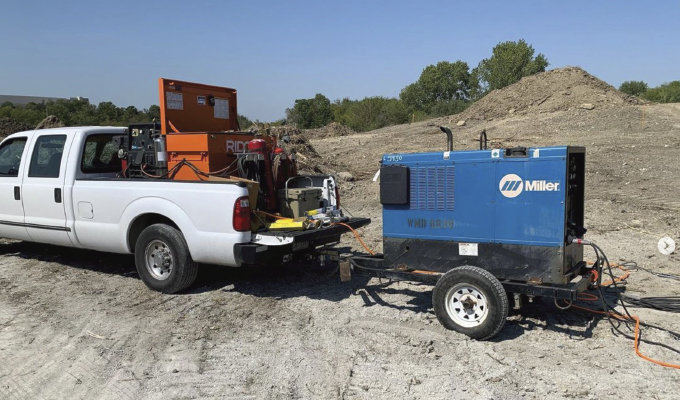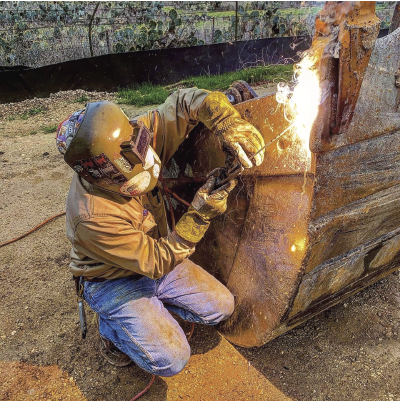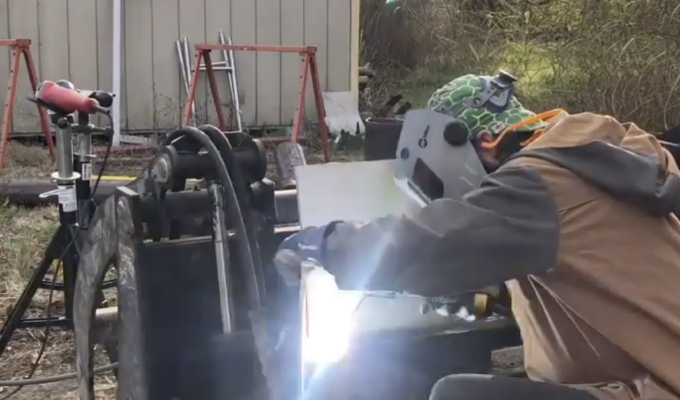Mobile welding typically involves a wide variety of work—from heavy machinery repair one day to fabricating ornamental fences the next.
Having the right equipment and capabilities on your truck is critical to achieving success in field fabrication.
What are the most important factors in starting a mobile welding business, and what types of tools should you invest in? Learn more from three field fabrication professionals.
1. PICK A FOCUS AREA
Before launching a mobile welding business, it’s important to know your region and the potential customer base. Are there any unmet welding needs? This can help create demand for your services. Heavy equipment or compact equipment repair are often a need in many communities and can provide steady work. Understanding the needs of your area and determining the work you’ll focus on will help you choose tools and set your hourly rate.
“Heavy equipment repair keeps me really busy. I work on bulldozers, large trenching machines, excavator booms, backhoes,” says Isaac Carrion, owner of Welding Repair Services in Austin, Texas. “I’d say 90% or more of my work is in the field, but I also do small repairs or fabrication on aluminum or stainless steel in my shop.”
2. TAKE ADVANTAGE OF EXISTING CONTACTS
In regions where demand is high for mobile welding services, word of mouth may be all that’s needed to grow your business. But it’s always helpful to use existing contacts to get started. If you have experience as a mechanic or in welding, construction or fabrication, those fields can provide fruitful ground to build a mobile welding business. Reach out to industry contacts along with companies and rental houses to let them know what services you offer. Building relationships is also important for gaining repeat business.

3. BUILD IN EXTRA TIME
Missing a projected quote is a fast lesson on estimating jobs. Going over the time you quoted means you’re essentially working for free. It’s often a good practice to build more time into a job than you think it will take. Repairs may be more involved than you first realized, or perhaps you don’t have all the details from the customer before the project starts.
“Typically, it’s always going to take longer than you think,” says Mike McAllister, fabricator for a fisheries and wildlife agency in West Virginia with a side business in welding and field fabrication. “Once you’ve missed your projected quote, it’s a learning lesson and you try to adjust for it and learn how to reliably estimate jobs.”
4. MANAGE YOUR SCHEDULE CAREFULLY
It’s OK to say no to jobs. That may seem counterintuitive when you’re building a new business. But if you get overloaded with too much work, the quality of what you’re producing can suffer—and harm your relationships with customers. That’s not a good way to get repeat business or earn referrals. Learn how to politely say no when your schedule is booked or when it’s a project that won’t benefit your business. Some jobs take a few hours, while others can last a week or more. That can be tough on scheduling, so it’s important to have flexibility in your schedule when jobs need to be adjusted.
“As a beginner you want to do it all, and that drive is great, but you have to learn balance above all else,” Carrion says. “Just like any business, my business opens and closes at a certain time and customers have learned to appreciate that.”
Setting aside time for office work is also key. You may want to be in the field all day every day, but staying on top of bills, receipts, and invoices is what keeps your business running. It may help to block off the same window each day or week to establish a routine for these tasks.
5. DETERMINE A BUDGET AND STICK TO IT
Proper budgeting is crucial to success for any small business. If you’re unsure about the best way to do this, look for resources online or take a course at your local community college.
Beyond the basics of budgeting for a business, you need to figure out your comfort zone for purchases. How much are you willing to extend yourself financially to purchase the equipment and tools you need to get started? Consider buying used tools and equipment, which can be an economical way to get started. But you also need to think about what equipment needs you’ll have down the road as you grow. While it’s often better to pace your purchases as you build the business, you also don’t want to purchase equipment that you will immediately outgrow.
6. CHOOSE EQUIPMENT WISELY

The equipment and tools you will need most depend on the type of jobs you expect to take on. You should also consider what welding processes you’ll use most often and your budget for equipment investments.
The most important capabilities for field fabrication are welding, power generation, and compressed air. Welding and carbon-arc gouging are processes most field fabricators use daily. Having one machine that provides all of those capabilities, like a welder/generator with a built-in air compressor, can save space on your truck and reduce the amount of equipment maintenance you must do. Having multi-process welding capabilities will make you more versatile and flexible to take on different jobs.
Choosing a heavy-duty work truck versus a half-ton truck makes a big difference for equipment capacity. Plan ahead and choose a truck that provides the ability to grow as the business grows. You may need more space and weight capabilities to haul more tools and equipment later.
“Invest in things that make you more efficient. Start with a good, reliable truck and a good, reliable generator. A wire feeder is another great investment,” says David DeMoise, owner of DeMoise Welding and Fabrication in Dallas. “All of these tools end up getting heavy fast, so if you have a truck that’s barely adequate, you end up working it to death and will spend a lot of time on maintenance and repairs.”
GETTING STARTED
Whether field fabrication is a side gig while you’re working another job or you go all-in to start a mobile welding business, the most important first step is having a solid business plan. This includes picking a focus area, building contacts, setting a budget and purchasing a truck and equipment.
CLOSING THOUGHT
“Starting a welding business can be tough initially. You’re trying to build your customer base and you weld anything—you’re doing lawnmower decks and your neighbor’s fence,” Carrion says. “It’s very similar to jumping off a high diving board. You’re scared to do it, but once you do it you realize the water’s not that bad.”
About the Author:
Brian Bellile is a product manager with Miller Electric Mfg. LLC. For more, visit www.millerwelds.com.
Modern Contractor Solutions, February 2023
Did you enjoy this article?
Subscribe to the FREE Digital Edition of Modern Contractor Solutions magazine.



